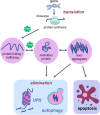Effects of Physical Exercise on Autophagy and Apoptosis in Aged Brain: Human and Animal Studies
- PMID: 32850930
- PMCID: PMC7399146
- DOI: 10.3389/fnut.2020.00094
Effects of Physical Exercise on Autophagy and Apoptosis in Aged Brain: Human and Animal Studies
Abstract
The aging process is characterized by a series of molecular and cellular changes over the years that could culminate in the deterioration of physiological parameters important to keeping an organism alive and healthy. Physical exercise, defined as planned, structured and repetitive physical activity, has been an important force to alter physiology and brain development during the process of human beings' evolution. Among several aspects of aging, the aim of this review is to discuss the balance between two vital cellular processes such as autophagy and apoptosis, based on the fact that physical exercise as a non-pharmacological strategy seems to rescue the imbalance between autophagy and apoptosis during aging. Therefore, the effects of different types or modalities of physical exercise in humans and animals, and the benefits of each of them on aging, will be discussed as a possible preventive strategy against neuronal death.
Keywords: aging; apoptosis; autophagy; brain; exercise.
Copyright © 2020 Andreotti, Silva, Matumoto, Orellana, de Mello and Kawamoto.
Figures




References
Publication types
LinkOut - more resources
Full Text Sources

